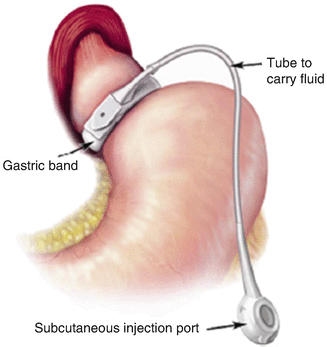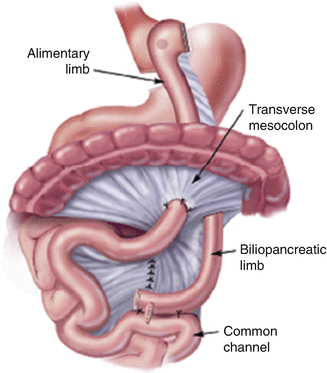Fig. 6.1
Sleeve gastrectomy . From Jones DB, Maithel SK, Schneider BE. Atlas of minimally invasive surgery. Woodbury CT: Cine-Med; 2006. Copyright Cine-Med Inc.; with permission
6.3.2 Laparoscopic Adjustable Gastric Banding
An adjustable silicone band is placed laparoscopically around the cardia of the stomach, 1–2 cm below the gastroesophageal junction and locked into place (Fig. 6.2) [21]. The band is connected to a port located in the subcutaneous tissue. Injection and withdrawal of saline via the port controls the tightness of the band and thus the degree of restriction offered by it [25, 26]. LAGB placement accounted for 46 % of all bariatric procedures performed in American College of Surgery accredited centres in 2011 [24]. Early complications of the procedure are rare and include slippage, obstruction, gastric or esophageal perforation, and port site infection [27]. The long-term safety and efficacy of LAGB is less clear with reported rates of surgical failure of up to 40 % at 5 years [28].


Fig. 6.2
Laparoscopic adjustable gastric band . From Jones DB, Maithel SK, Schneider BE. Atlas of minimally invasive surgery. Woodbury CT: Cine-Med; 2006. Copyright Cine-Med Inc.; with permission
6.3.3 Laparoscopic Roux-en-Y Gastric Bypass
The restrictive portion of this procedure involves the creation of a 20–30 mL gastric pouch from the proximal lesser curve of the stomach through the sequential firing of a linear stapler [29]. A biliopancreatic limb, an alimentary limb, and a common channel result from the creation of the Roux-en-Y anastomosis (Fig. 6.3) [21]. The biliopancreatic limb extends from the ligament of Treitz to the jejunojejunostomy and is generally 30–60 cm in length. The alimentary limb extends from the gastrojejunostomy to the jejunojejunostomy. It is typically 75–150 cm long and carries the ingested food without biliary and pancreatic secretions. The common channel refers to the remainder of the small intestine extending from the jejunojejunostomy to the ileocecal valve [26]. LRYGB results in greater reduction in BMI than the LSG or the LAGB. The specific surgical complications associated with this procedure include anastomotic leak, bleeding, internal hernia, marginal ulcer, and staple line failure [30]. LRYGB is associated with a 30-day mortality of 0.14 % and a 30-day morbidity of 5.91 % [24].


Fig. 6.3
Laparoscopic Roux-en-Y gastric bypass . From Jones DB, Maithel SK, Schneider BE. Atlas of minimally invasive surgery. Woodbury CT: Cine-Med; 2006. Copyright Cine-Med Inc.; with permission
6.3.4 Biliopancreatic Diversion
This procedure consists of a distal gastrectomy combined with a long Roux-en-Y reconstruction [31]. In a variation of the procedure called biliopancreatic diversion (BPD) with duodenal switch, the pylorus is preserved and an ileoduodenostomy is created distal to the pylorus. In this procedure, the length of the common channel varies between 50 and 125 cm from the ileocecal valve and determines the degree of malabsorption [26]. There are no clear indications for when to perform BPD. It can be considered in super obese patients, given its superior weight loss results compared to LRYGB [32].
6.4 Outdated Procedures
6.4.1 Jejunoileal Bypass
In this procedure, the jejunum is divided proximally; variable lengths of small intestine are then excluded before this segment of jejunum is anastomosed distally to the ileum. The jejunoileal bypass has been abandoned due to reports that greater than 20 % of patients who underwent this procedure developed life-threatening complications [33]. These complications include progressive liver disease, intractable diarrhea and electrolyte abnormalities, kidney stones and renal failure resulting from hyperoxaluria, and migrating arthralgias [33].
6.4.2 Vertical Band Gastroplasty
A vertical staple line is used to partition the upper portion of the stomach, which results in the formation of a tight outlet. This outlet is then wrapped with a band or mesh to prevent dilation over time [26]. This procedure has been abandoned due to failure to maintain weight loss over time [34]. Furthermore, up to 56 % of patients undergoing this procedure ultimately require revisional surgery due to complications such as leakage and fistula formation, scarring and stricture formation, and gastroesophageal fistula formation [26, 35].
6.5 Evidence for Treating Severe Obesity
The prospective, controlled Swedish Obesity Subjects study followed over 4000 obese patients, with half undergoing a bariatric procedure and a matched control group undergoing conventional treatment [36]. The study reported on mortality over a 10.9 year period, with a 99.9 % follow-up rate. The hazard ratio (adjusted for sex, age, and risk factors) for the surgery group was 0.71 compared to the control group [36]. Thus, the study demonstrated that bariatric surgery is associated with decreased overall mortality [36].
In 2011, the American College of Surgeons—Bariatric Surgery Centre Network (ACS-BSCN) published its first report on the safety and efficacy of LAGB, LSG, and LRYGB [24]. At 1 year, patients undergoing LAGB, LSG, and LRYGB had a BMI reduction of 7.05, 11.87, and 15.34, respectively [24]. Additionally, the clinical efficacy of these procedures for the treatment of five weight-related comorbidities was assessed; these included diabetes, hypertension , hyperlipidemia , obstructive sleep apnea (OSA) , and gastroesophageal reflux disease (GERD) . In diabetic patients, 44 % had resolution or improvement of their disease following LAGB, 55 % following LSG, and 83 % following LRYGB [24]. Forty-four percent of hypertensive patients had disease resolution or improvement after LAGB, 68 % after LSG, and 79 % after LRYGB [24]. Similar results were seen for the remaining three comorbidities studied with the efficacy of LSG lying intermediate between that of the LAGB and the LRYGB (Table 6.1) [24]. In obese patients with uncontrolled Type 2 diabetes mellitus, Schauer et al. reported that 3 years of intensive medical therapy combined with bariatric surgery resulted in better glycemic control than medical therapy alone [19]. In a study by Pournaras et al., 72 % of diabetic patients undergoing gastric bypass were deemed to be in remission from their disease and improvements in insulin resistance have been found to precede weight loss [37]. Bariatric surgery is also found to be associated with improved glycemic control in non-morbidly obese patients with BMIs between 30 and 35 [38].
Table 6.1
Rates of improvement or resolution of obesity-related comorbidities by bariatric surgery type [8]
1 year outcome | Laparoscopic RYGB | Lap sleeve gastrectomy | Lap band |
|---|---|---|---|
Reduction in BMI (kg/m2) | −15.34 | −11.87 | −7.05 |
Diabetes | 83 % | 55 % | 44 % |
Hyperlipidemia | 66 % | 35 % | 33 % |
Hypertension | 79 % | 68 % | 44 % |
Obstructive sleep apnea | 66 % | 62 % | 38 % |
GERD | 70 % | 50 % | 64 % |
A large, prospective, multicentre, observational study of 30-day outcomes by the Longitudinal Assessment of Bariatric Surgery (LABS) consortium demonstrated a low 30-day rate of death among patients undergoing Roux-en-Y gastric bypass or LAGB of 0.3 % [39]. The rate of 30-day morbidity was also found to be low with 4.3 % of patients having at least one major adverse outcome [39]. The advent of laparoscopic bariatric procedures has greatly improved the safety profile of these interventions. 30-day rate of death was 2.1 % for open Roux-en-Y gastric bypass compared to 0.2 % for LRYGB [39]. Of the three most commonly performed laparoscopic bariatric procedures, the morbidity associated with LSG (5.61 %) is intermediate between that of LAGB (0.92 %) and LRYGB (5.91 %) [8]. Similarly, the mortality risk associated with LSG (0.11 %) is intermediate between than of LAGB (0.05 %) and LRYGB (0.14 %) [24] (Table 6.2).
Laparoscopic RYGB (%) | Lap sleeve gastrectomy (%) | Lap band (%) | |
|---|---|---|---|
30-day mortality | 0.14 | 0.11 | 0.05 |
1-year mortality
Stay updated, free articles. Join our Telegram channel
Full access? Get Clinical Tree
 Get Clinical Tree app for offline access
Get Clinical Tree app for offline access

|


